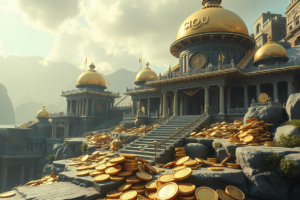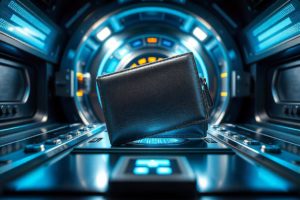Real world assets (RWAs) are physical or traditional assets like real estate, commodities, debt instruments, and various financial contracts that are being tokenized on blockchains. Tokens representing ownership related to RWAs are bringing new liquidity and accessibility to previously illiquid markets.
What Are Real World Assets?
Real world assets are assets that have tangible value from representing ownership of physical things, financial agreements, or cash flows originating in the real economy. Some examples include real estate property, precious metals, corporate bonds, commercial debt obligations, rental income streams, agricultural goods like crops or livestock, royalties from intellectual property, and various forms of insurance-based contracts.
A 2021 insight report by the World Economic Forum, pegs the potential market size of the RWAs sector in the hundreds of trillions of dollars. As a matter of fact, anything that has an offline intrinsic or contractual value that can be reliably quantified can potentially be represented by tokens on a blockchain.
Why Tokenize Real World Assets?
There are several major benefits that tokenization unlocks for real world assets. For instance, turning traditionally illiquid assets like private equity or real estate into tokens traded 24/7 on exchanges vastly improves their saleability and the ability to exit positions. Enhanced liquidity makes RWAs more appealing to investors and owners.
Similarly, allowing small portions of high-value assets to be represented by tokens lowers barriers to investment through fractionalization. Anyone can own and trade $20 in real estate instead of needing $100,000 upfront. Other benefits include:
Speed & Efficiency – Automated smart contracts enable near-instantaneous trading and settlement finality versus long lag times in legacy systems. This improves access and velocity of capital flows.
New Markets – Digitizing new assets that were previously inaccessible, too localized, or too complex creates expanded investment opportunities.
Transparency – On-chain data like property deed history and cash flow distributions provide visibility into asset provenance and performance.
Programmability – Controlling RWAs with smart contract instructions enables dynamic functionality compared to static paper-based agreements.
Overall, tokenizing real world assets unlocks exponential improvements in market accessibility, efficiency, transparency, automation, and innovation.
What Types of Real-World Assets Are Tokenized?
Many categories of real-world assets are being tokenized on blockchains, with the most common being real estate and art. In real estate, both residential and commercial properties like apartments, office buildings, hotels, storage facilities, medical centers, and unused land can be tokenized.
In March 2023, LinksDAO won a bid to buy an 18-hole golf course in Scotland, worth around $900000. Prior to this, CityDAO bought 40 acres near Yellowstone National Park, using the Wyoming DAO LLC law.
The interesting thing about these IRL purchases is that these assets are collectively owned, managed, and governed by members of the decentralized communities. Members can also freely exit their positions if they no longer want to be a part of the group. Although not comprehensive, here’s a brief list of other real-world assets that can be tokenized.
- Commodities – Precious metals like gold, silver, and platinum as well as base metals. Oil, natural gas, and other energy industry commodities. Agricultural goods including corn, wheat, coffee beans, and livestock.
- Debt instruments – Corporate bonds, municipal bonds, treasury bonds, mortgage bonds, commercial paper, and various notes or loans between entities.
- Financial contracts – Derivatives like options, futures, and swaps. Insurance contracts for vehicles, real estate, businesses, and life. Royalties from patents, copyrights, and mineral rights.
Essentially any high-value projects or agreements with reliable cash flows that generate passive income or require collateralization can be tokenized. Once market price data is available, even unconventional assets like stadiums or solar farms can become tokenized.
How Do Real World Asset Tokens Work?
There are two primary approaches for digitally representing real world assets on blockchains:
- Tokenizing Ownership – Issuing tokens that represent fractional ownership in the asset. Holders collectively own the physical or virtual item and share returns.
- Tokenizing Obligations – Issuing tokens that represent IOUs or contractual rights to things like cash flows, dividends, or voting from the asset. Tokens reference off-chain agreements.
In the first model, the asset itself is programmatically controlled, like tokenized shares in a rental property paying dynamic dividends. In the second, smart contracts automate payments, tracking, and other duties around contractual obligations tied to a real world asset. Hybrid approaches are also possible. Both rely on trusted price feeds to determine token values.
For example, a REIT (Real Estate Investment Trust) that owns an office building might tokenize voting shares of the property’s ownership as tokens on Ethereum. On the obligations side, mortgages on a building could be represented by tokens entitled to the building’s monthly mortgage payments until satisfied.
Real World Assets in Action
A number of blockchain projects are already working on tokenizing different real world asset classes. RealT for example, tokenizes residential and commercial real estate on Ethereum, offering fractional property ownership and trading. The platform offers several properties, primarily single-family homes in the United States, with investments starting as low as $100.
DECENOMY, however, advances beyond the RWA approach by not merely tokenizing assets but by fostering a decentralized economic ecosystem. Unlike RWAs, which focus on liquidity and market access, DECENOMY integrates cryptocurrencies with real economic values, emphasizing value creation and efficiency.
What sets DECENOMY apart is its balanced emphasis on economic, social, and environmental principles. It aims to ensure that digital currencies are not only economically viable but also socially responsible and environmentally sustainable. This approach addresses the shortcomings of traditional financial systems by promoting investments that have a positive impact on society and the planet.
In summary, while RWAs provide a valuable link between tangible assets and the digital economy, DECENOMY builds a comprehensive economic model that values social and environmental stewardship as much as economic growth. Through DECENOMY, digital assets gain deeper meaning, reflecting a commitment to a sustainable and equitable digital financial world. It’s clear that the future of digital asset management lies in creating an inclusive economy that benefits all.
In addition to the tokenization of real word assets, Decenomy introduces a reward mechanism. By using smart contracts embedded in NFTs, owners receive rewards based on the performance or appreciation of the underlying property.
Benefits of Investing in Real World Asset Tokens
- Increased liquidity compared to owning illiquid whole assets or partnership shares.
- Lower investment minimums by buying fractional portions of high-value property or debt offerings.
- Transparent prices and performance data are recorded immutably on the blockchain ledger.
- Near instant settlement of purchases without long transfer delays.
- Potential for higher returns from expanded accessibility and faster velocity of trading.
- Collateralization and smart contract automation reduce counterparty default risk.
- Ability to own shares across diverse asset classes rather than just publicly traded stocks and bonds.
Risks of Investing in Real World Asset Tokens
- Nascency risk of new technology and markets with limited performance history.
- Ongoing dependence on responsible token sponsors to manage assets.
- Illiquidity if trading platforms and market makers do not emerge.
- Regulatory uncertainty as jurisdictions define the treatment of asset-backed tokens.
- Technical risks like smart contract bugs, oracle failures, and cybersecurity breaches.
- Fraud potential if token sponsors misrepresent assets or mishandle funds.
Thorough vetting and due diligence are essential before investing material sums into real world asset tokens. As the ecosystem matures, many risks will be reduced or eliminated. Conservative portfolio allocations are prudent until the category reaches broader adoption.
Conclusion
In the evolving digital finance landscape, Real World Assets (RWAs) like real estate and commodities are being tokenized on blockchains, enhancing liquidity and accessibility for traditionally illiquid markets. This process democratizes investment through fractional ownership and improves market efficiency.
DECENOMY builds on RWA tokenization by integrating cryptocurrencies with real economic values, going beyond liquidity to emphasize economic growth, social responsibility, and environmental sustainability. This approach creates a more comprehensive economic system, offering meaningful and sustainable investment opportunities that align digital assets with the real economy’s needs.
As such, DECENOMY represents a significant step forward in digital asset management, promising a future where investments contribute positively to society and the environment, setting a new standard for the digital financial world.
















